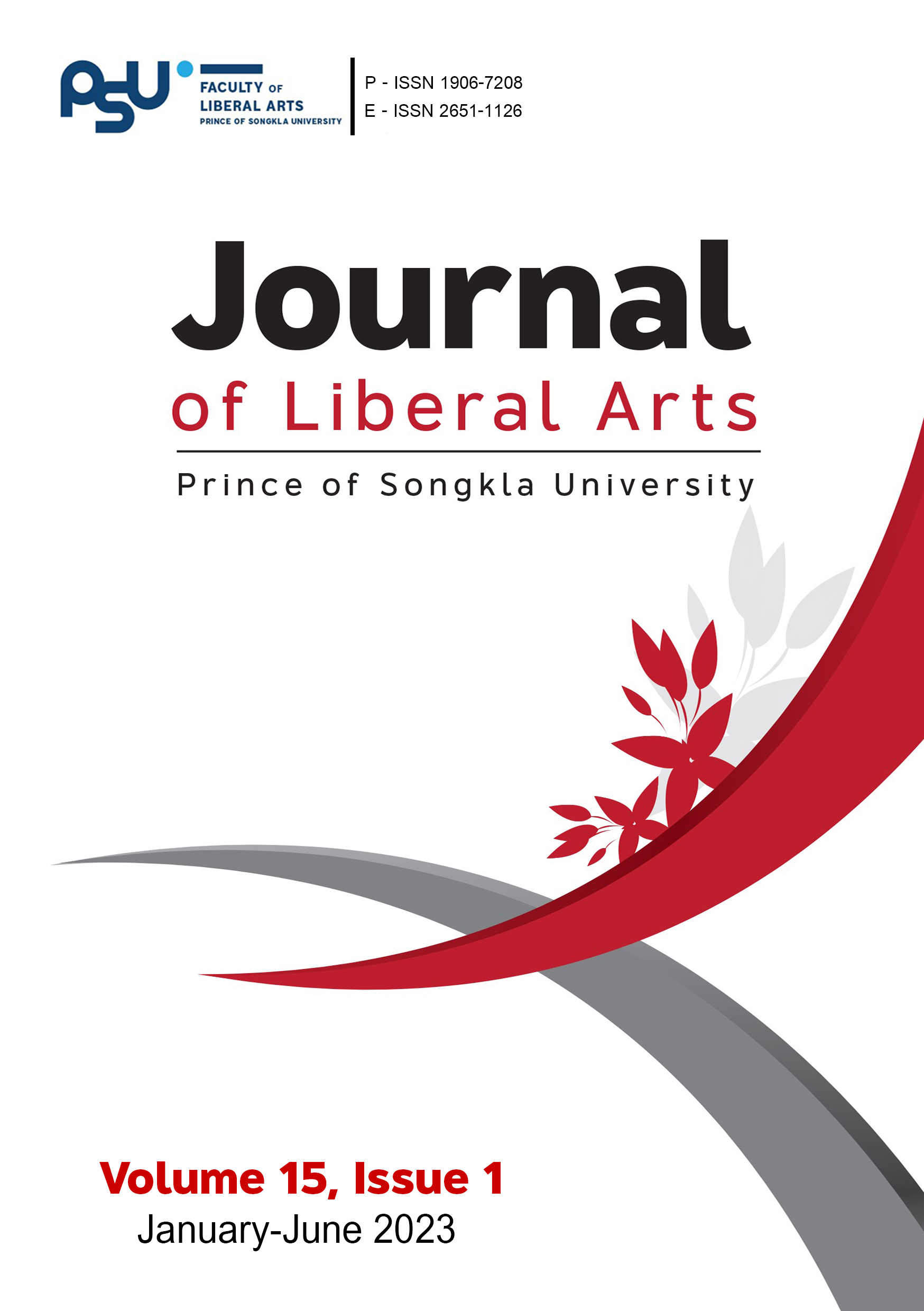From Vlogpologies to Digital Dialogues: Decoding YouTubers' Speech Act and Audience Comments
DOI:
https://doi.org/10.14456/jlapsu.2023.9Keywords:
speech act of apology, YouTubers, comments analysis, types of tonesAbstract
This study aims to investigate the apology strategies used by famous YouTubers in their vlogpologies, as well as to explore the potential relationship between these strategies and the tones expressed in the comment section. The researchers employed purposive sampling to select eight video clips created by eight well-known YouTubers, along with the top ten most-liked comments of each video, resulting in a total of eighty comments. The speech act set developed by Cohen and Olshtain (1981) was utilized as a schema to analyze the apology strategies. Zhang's (2016) content analysis approach was applied to code, categorize, and interpret the tones expressed in the comments in addition to the tone interpretation method proposed by Pearl and Steyvers (2013). The findings indicated that acknowledgement of responsibility, expression of apology, and explanation or account were the most frequently used strategies. The analysis of the comments section revealed that the tones expressed in response to the videos were divided between positive and negative feedback, with some videos receiving mixed responses. However, no significant relationship was observed between the apology strategies and the tones expressed in the comments. The results of this study have implications for our understanding of the dynamics of speech act of apology in the digital era and highlight the importance of considering various factors that can influence audience responses to apologies, i.e. intensity of offense, familiarity with the person being apologized to, or relative authority that each of an interactant has (CARLA, 2021).
References
Abudin, B., & Sundari, H. (2021). Exploring apology strategy by Indonesian public figures: A pragmatic study in social media. DEIKSIS, 13 (2), 122-133.
Auxier, B., & Anderson, M. (2021, April 7). Social media use in 2021. Retrieved from https://www.pewresearch.org: https://
www.pewresearch.org/internet/2021/04/07/social-media-use-in-2021/
Bergman, M. L., & Kasper, G. (1991). The interlanguage of apologizing: Cross-cultural evidence. ESL, 2(10), 139-176.
CARLA. (2021). American English apologies. Retrieved May 1, 2023, from https://carla.umn.edu: https://carla.umn.edu/
speechacts/apologies/american.html
Cheng, D. (2013). Student instructor apologies: How are they preduced and percieved? [Doctoral Dissertation, Northern Arizona University].
Cohen, A. D., & Olshtain, E. (1981). Developing a measure of socio-cultural competence: The case of apology. Language Learning. 31(1), 113-133.
Dixon, S. (2023, February 13). Number of social media users worldwide from 2017 to 2027. Retrieved from www.statista.com:https://www.statista.com/statistics/278414/number-of-worldwide-social-network-users/#:~:text=In%202021%2C%20over%204.26%20billion,almost%20six%20billion%20in%202027.
Geyser, W. (2022, June 20). How to become a YouTuber – The ultimate checklist. Retrieved fromhttps://influencermarke
tinghub.com: https://influencermarketinghub.com/how-to-become-a-youtuber/
Grant, S., & Kim , S. G. (2020, January 28). 15 of YouTube's most horrifying scandals and controversies. Retrieved from https://www.seventeen.com/celebrity/movies-tv/g18753797/youtube-scandals-controversies/
Holmbom, M. (2015). The YouTuber : A qualitative study of popular content creators [Research Report]. Semantic Scholar. chrome-extension://efaidnbmnnnibpcajpcglclefindmkaj/http://umu.diva-portal.org/smash/get/diva2:825044/FULLTEXT01.pdf
Kakkar, A., & Samora, R. (2020). The aftermath of a YouTube apology. Retrieved from www.pudding.cool: https://pudding.cool/2020/01/apology/
Karlsson, G. (2020). The YouTube apology. [Master’s Thesis, Malmö University].
Loisa, J. (2021). "I’m just letting everyone know that I’m an idiot":Apology Strategies in YouTubers’ Apology Videos. [Master’s Thesis, University of Eastern Finland].
Morris, K., & Chiba, A. (2016, January 22). Descriptions of speech acts. carla.umn.edu: http://www.carla.umn.edu/speechacts/
descriptions.html
Pearl, L., & Steyvers, M. (2013). “C’mon – You Should Read This”: Automatic identification of tone from language text. International Journal of Computational Linguistics (IJCL), 4(1), 12-30.
Planalp, S. (1996). Communicating emotion in everyday life: Cues, channels, and processes. In P. A. Andersen, & L. K. Guerrero, Handbook of Communication and Emotion: Research, Theory, Applications, and Contexts (pp. 29-48). Academic Press.
S.L.Lai, L., & To, W. (2015). Content analysisof social media: A grounded theory approach. Journal of Electronic Commerce Research, May 2015, 138-152.
Sabilla, A., & Jusmaya, A. (2020). An analysis of apology strategies in the Ellen Degeneres show: Pragmatics Approach. Jurnal Ilmiah Mahasiswa, 2(3), 122-133.
Sandlin, J. K., & Gracyalny, M. L. (2018). Seeking sincerity, finding forgiveness: YouTube apologies as image repair. Public Relations Review, 44(3), 393-406.
Shepherd, J. (2023, February 23). 22 essential YouTube statistics you need to know in 2023. The Social Shepherd. https://thesocialshepherd.com/blog/youtube-statistics
Storms, R. (2022, March 13). Top 10 worst YouTubers of all time. TheTopTen. https://www.thetoptens.com/youtube/worst-youtubers/
Tastyedit. (2023, March 18). The biggest 2023 YouTube trends influencers need to know about. Tastyedits https://www
.tastyedits.com/biggest-youtube-trends-for-influencers/
YouTube. (2023, April 28). About YouTube. https://about.youtube/
Zhang, N. (2016). Public perceptions of genetically modified food on social media: A content analysis of Youtube comments on videos . [Master’s Thesis, University of South Carolina].
Downloads
Published
How to Cite
Issue
Section
License
Copyright (c) 2023 Pitichon Muangkaew, Autsadee Poonkaew, Piyatida Idsa, Phrueksa Kaewgonnoi, Uraiwan Rattanapan Noonkong

This work is licensed under a Creative Commons Attribution-NonCommercial-NoDerivatives 4.0 International License.
The authors retain the copyright to their article but the Journal of Liberal Arts, Prince of Songkla University reserves the exclusive rights to first publication.






